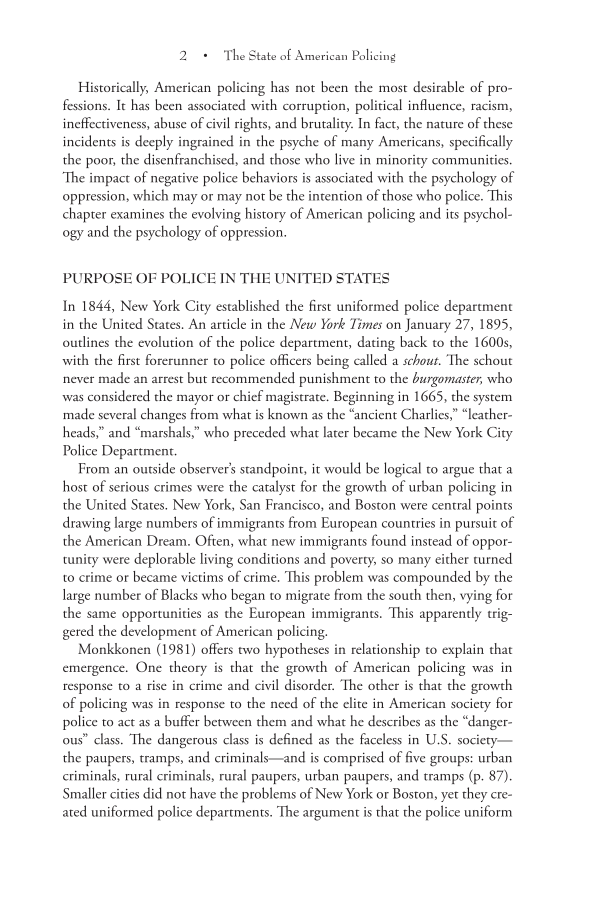2 • The State of American Policing Historically, American policing has not been the most desirable of pro- fessions. It has been associated with corruption, political influence, racism, ineffectiveness, abuse of civil rights, and brutality. In fact, the nature of these incidents is deeply ingrained in the psyche of many Americans, specifically the poor, the disenfranchised, and those who live in minority communities. The impact of negative police behaviors is associated with the psychology of oppression, which may or may not be the intention of those who police. This chapter examines the evolving history of American policing and its psychol- ogy and the psychology of oppression. PURPOSE OF POLICE IN THE UNITED STATES In 1844, New York City established the first uniformed police department in the United States. An article in the New York Times on January 27, 1895, outlines the evolution of the police department, dating back to the 1600s, with the first forerunner to police officers being called a schout. The schout never made an arrest but recommended punishment to the burgomaster, who was considered the mayor or chief magistrate. Beginning in 1665, the system made several changes from what is known as the “ancient Charlies,” “leather- heads,” and “marshals,” who preceded what later became the New York City Police Department. From an outside observer’s standpoint, it would be logical to argue that a host of serious crimes were the catalyst for the growth of urban policing in the United States. New York, San Francisco, and Boston were central points drawing large numbers of immigrants from European countries in pursuit of the American Dream. Often, what new immigrants found instead of oppor- tunity were deplorable living conditions and poverty, so many either turned to crime or became victims of crime. This problem was compounded by the large number of Blacks who began to migrate from the south then, vying for the same opportunities as the European immigrants. This apparently trig- gered the development of American policing. Monkkonen (1981) offers two hypotheses in relationship to explain that emergence. One theory is that the growth of American policing was in response to a rise in crime and civil disorder. The other is that the growth of policing was in response to the need of the elite in American society for police to act as a buffer between them and what he describes as the “danger- ous” class. The dangerous class is defined as the faceless in U.S. society— the paupers, tramps, and criminals—and is comprised of five groups: urban criminals, rural criminals, rural paupers, urban paupers, and tramps (p. 87). Smaller cities did not have the problems of New York or Boston, yet they cre- ated uniformed police departments. The argument is that the police uniform
Document Details My Account Print multiple pages
Print
You have printed 0 times in the last 24 hours.
Your print count will reset on at .
You may print 0 more time(s) before then.
You may print a maximum of 0 pages at a time.




































































































































































































































